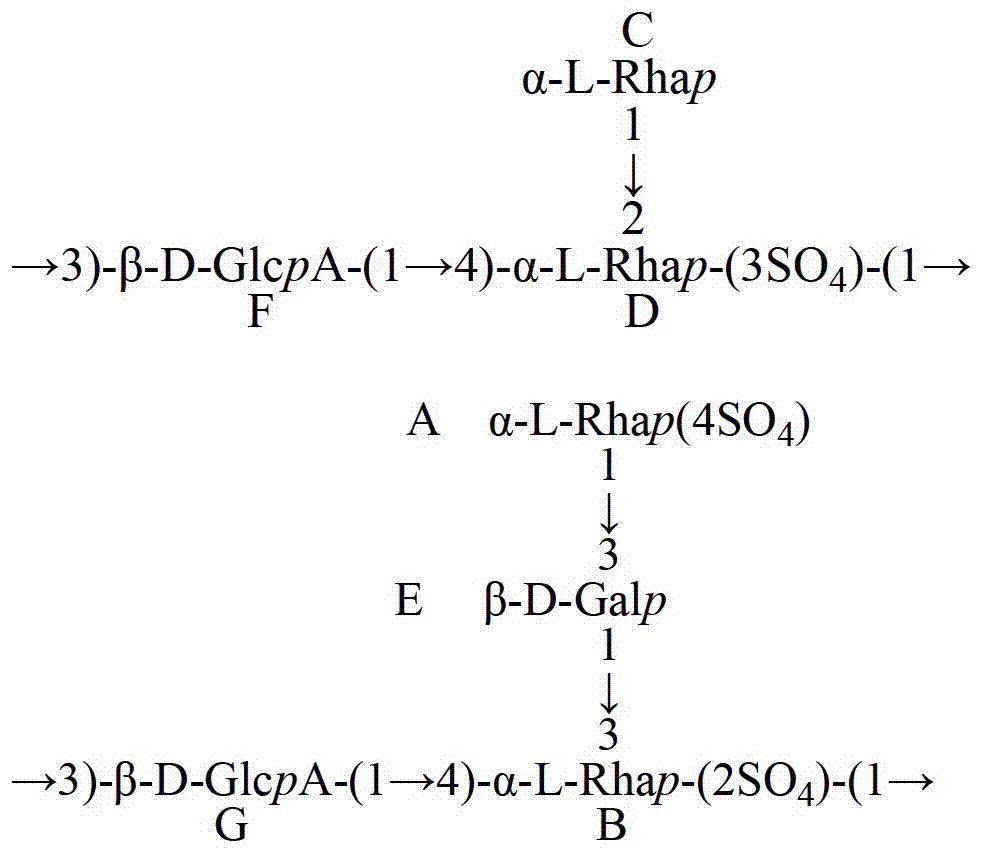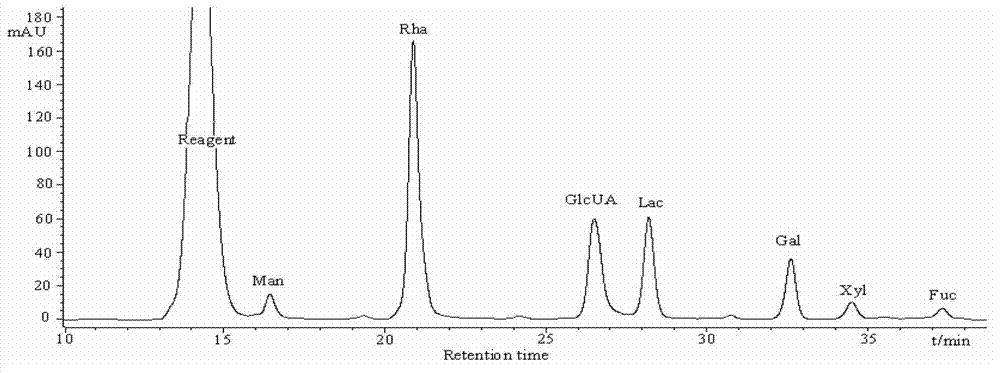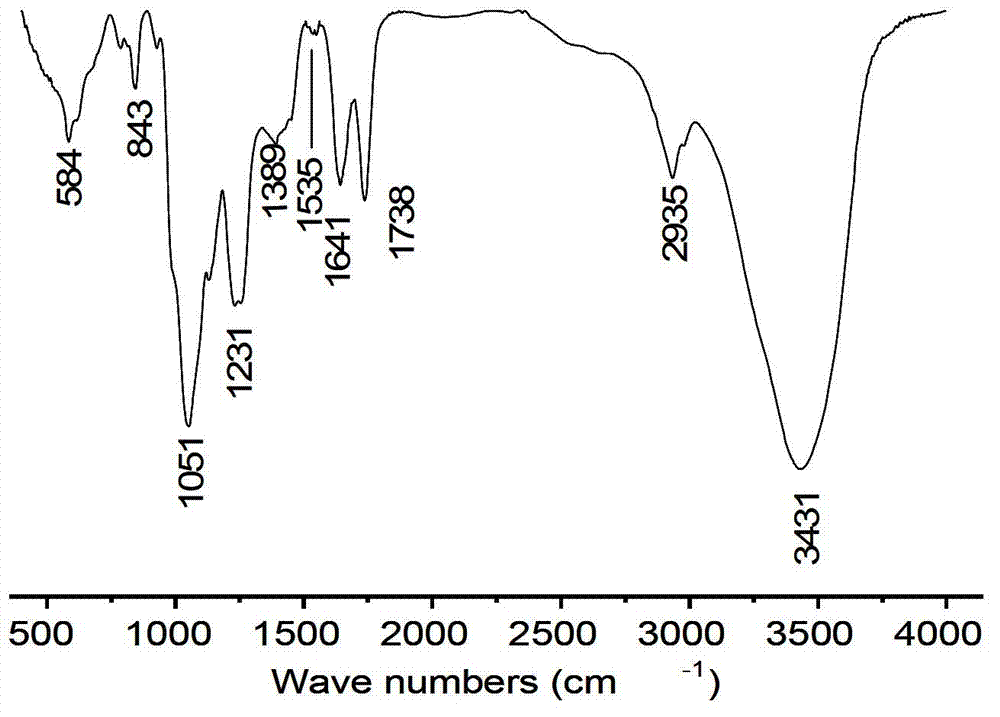Abalone viscera acidic polysaccharose and health-care product containing abalone viscera acidic polysaccharose and application of abalone viscera acidic polysaccharose
A technology of acidic polysaccharides and abalone viscera, applied in the field of polysaccharides, can solve environmental pollution, reduce the value of abalone and other problems, and achieve the effect of promoting proliferation
- Summary
- Abstract
- Description
- Claims
- Application Information
AI Technical Summary
Problems solved by technology
Method used
Image
Examples
Embodiment 1
[0045] Example 1: Extraction and separation and purification of acidic polysaccharides from abalone viscera, the following steps are carried out in sequence:
[0046] 1) Grind 100g of dried abalone viscera into powder, add 2000mL of mixed chloroform-methanol (V:V, 2:1) mixed solution, soak for 12h, filter, and dry the filter residue.
[0047] 2) Take the dried abalone viscera powder obtained in step 1), add 3000mL of mixed buffer solution, and add 10g of papain, and stir and react in a water bath at 60°C for 24 hours. The preparation method of the mixed buffer solution is as follows: - Add 5 mmol of EDTA and 5 mmol of cysteine to sodium acetate buffer solution (pH 6.0).
[0048]3), centrifuge the enzymolysis product obtained in step 2) (2000g, 15min, 20°C), add 80mL of cetylpyridinium chloride (CPC) aqueous solution with a mass concentration of 10% to the obtained supernatant, and After being left for 24 hours, it was centrifuged (2000g, 15min), and the supernatant was disc...
Embodiment 2
[0053] Example 2 Structural Analysis of the Abalone Visceral Acidic Polysaccharides Obtained in Example 1
[0054] 1) Take 2.0 mg of acidic polysaccharide from abalone viscera obtained in Example 1 above into an ampoule bottle, add 1 mL of 2mol·L-1TFA, seal the tube with nitrogen gas, and hydrolyze at 110°C for 8 hours. Then cool to room temperature, evaporate TFA at 50°C, adjust to neutral with 2mol L-1 and 0.3mol L-1 NaOH solution successively, dilute to 1mL with ultrapure water, take 450μL and 50μL internal standard Lactose was derivatized with PMP. Chromatographic conditions: Chromatographic instrument: Agilent 1100 high performance liquid chromatograph, chromatographic column: ZORBAX EclipseXDB-C18 separation column (4.6×150mm, 5μm), detector: UV detector, 245nm, flow rate: 1.0mL·min-1, column Temperature: 25°C, mobile phase: solvent A: 10% (V / V) acetonitrile + 0.1mol L-1 ammonium acetate-acetic acid buffer (pH 5.5), solvent B: 25% (V / V) acetonitrile + 0.1 mol L-1 ammon...
Embodiment 3
[0069] Example 3 Acidic polysaccharides from abalone viscera promote cell proliferation activity
[0070] 1) MTT method to detect the effect of polysaccharides on the proliferation of HepG2 cells. HepG2 cells in the logarithmic growth phase were prepared with RPMI-1640 complete medium (containing 10% newborn bovine serum) at a density of 2×10 4 pcs mL -1 The cell suspension was inoculated in a 96-well culture plate, 100 μL / well. After 24 hours of adherence, the concentration was changed to 25 μg·mL -1 , 50μg·mL -1 , 100μg·mL -1 , 200μg·mL -1 and 400μg·mL -1 For each concentration of polysaccharides, 4 replicate wells were set up, 200 μL / well. Add the same amount of complete medium to the blank control group. 37°C, 5% CO 2 After culturing for 24h, 48h and 72h under the same conditions, discard the medium and add MTT solution (prepared in PBS solution, the final concentration is 0.5mg·mL -1 ). After continuing to cultivate for 4 hours, suck off the supernatant, add aci...
PUM
| Property | Measurement | Unit |
|---|---|---|
| Average molecular weight | aaaaa | aaaaa |
Abstract
Description
Claims
Application Information
 Login to View More
Login to View More - R&D
- Intellectual Property
- Life Sciences
- Materials
- Tech Scout
- Unparalleled Data Quality
- Higher Quality Content
- 60% Fewer Hallucinations
Browse by: Latest US Patents, China's latest patents, Technical Efficacy Thesaurus, Application Domain, Technology Topic, Popular Technical Reports.
© 2025 PatSnap. All rights reserved.Legal|Privacy policy|Modern Slavery Act Transparency Statement|Sitemap|About US| Contact US: help@patsnap.com



